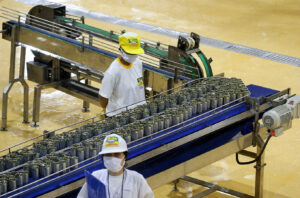Factory output slows to 3-month low in June

Manufacturing output eased to a three-month low in June dragged by contractions in the production of basic metals as well as coke and refined petroleum products, the Philippine Statistics Authority (PSA) said in a report.
Preliminary results of the PSA’s latest Monthly Integrated Survey of Selected Industries (MISSI) showed factory output, as measured by the volume of production index, slowed by 2.2% year on year in June.
The June reading was slower than the revised 3.4% in May and the 3.8% in June last year. It was also the slowest growth in three months or since the 0.8% dip in March.
In the first semester, factory output growth averaged 1.4%, slower than the 2% average in the same period last year.
On a monthly basis, June’s output contracted by 4.7%, a reversal from the 2.6% in May. Stripping out seasonality factors, it slipped by 2.5%.
According to the PSA, slowdown in factory output in June was due to the sharp annual declines in basic metals (-23.2% in June from -12.5% in May), coke and refined petroleum products (-12% from -6.1%), and chemicals and chemical products (-14.7% from -9.9%).
Five other divisions logged declines while the remaining 14 saw expansion.
The top three industry divisions that contributed to the overall year-on-year growth in the VoPI were food products (26.3% from 15.5%), transport equipment (13% from 14.8%), and computer, electronic and optical products (4.8% from 5%), the PSA said.
In comparison, the Philippines in S&P Global Manufacturing Purchasing Managers’ Index (PMI) expanded 50.7 in June from 50.1 in May, the strongest pace in two months.
PMIs are a leading indicator for factory activity, reflecting the volume of materials purchased in advance of manufacturing operations weeks or months down the line. A reading above 50 separates expansion from contraction.
Growth in factory output, particularly the deceleration in three industries, can be traced to more expensive imported production due to global trade uncertainties and a weaker peso, Cid L. Terosa, senior economist at the University of Asia and the Pacific, said.
“Although muted and slower than previous months, demand for locally manufactured goods appears to have been sustained amidst lower inflation,” Mr. Terosa said in an e-mail.
Philippine Chamber of Commerce and Industry Chairman Sergio R. Ortiz-Luis, Jr. said that “many exporters and manufacturers, slightly slowed down from May to June before they announced the (tariff) because they were afraid for it to expand.”
“Year on year we increased to a certain degree, but it was affected by the tariff of Trump,” he said in a phone interview in a mix of Filipino and English.
In April, US President Donald J. Trump announced a 17% reciprocal tariff rate for goods from the Philippines, but the implementation was suspended until July.
But earlier in July, he raised this levy to 20%. Following his meeting with Philippine President Ferdinand R. Marcos, Jr., Mr. Trump set a new 19% tariff on Philippine goods, which took effect on Aug. 7.
“Tariffs can lead to a decline in manufactured exports. Electronics and semiconductor exports, which comprise more than 50% of our exports to the US market, may not be affected much because electronics are covered by WTO (World Trade Organization) Information Technology agreements,” Mr. Terosa said.
For Nicholas Antonio T. Mapa, chief economist at Metropolitan Bank & Trust Co., manufacturing faces headwinds with Trump tariff of 19% imposed on the country.
“An additional challenge was the recently announced potential 100% tariff on electronics entering the US, which may dampen demand for electronic exports from the Philippines,” he said in a Viber message.
Marites M. Tiongco, dean at De La Salle University School of Economics, said that the country must diversify export destinations to “reduce US market concentration risk.”
Moving forward, Mr. Terosa flagged the effects of US reciprocal tariffs, weaker peso, and ongoing geopolitical tensions as emerging risks that could dampen the country’s manufacturing sector.
Manufacturing accounts for nearly 20% of the country’s gross domestic product. — Heather Caitlin P. Mañago











